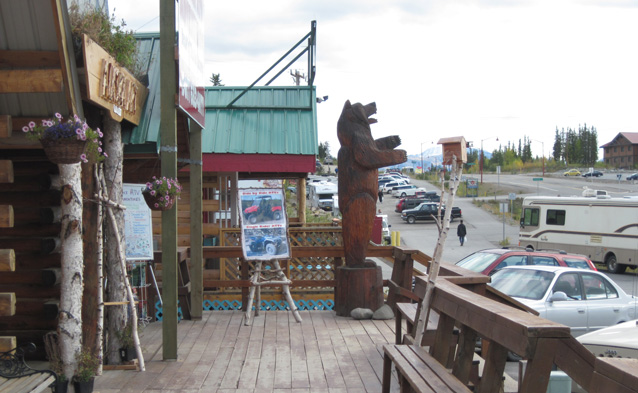
Lucy Tyrell
Whenever visitors to Denali National Park and Preserve pay to stay at Riley Creek Campground or at a hotel just outside the park, buy bus or train tickets, take a flightseeing trip, or even purchase an ice cream cone during a park visit, they contribute to the local economy as a direct result of their park visit.
In addition to the money visitors spend directly on goods, services, and lodging in the local area, national parks also affect the local, regional, national, and global economies in several ways: (1) the National Park Service (NPS) spends money to operate the park—e.g., payroll; goods and services from local, regional, and statewide suppliers; and expenses related to research and construction activities within the park; (2) local businesses hire employees; both groups spend money; (3) park concessioners make financial investments toward operations, employee room and board, and improving or maintaining visitor facilities; and (4) visitors make pre-trip purchases of outdoor gear (e.g., camping equipment, camera, binoculars, and clothing).
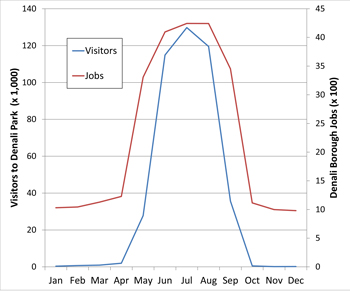
Parks, gateway communities, and economics
Communities that are “gateways” to national parks in Alaska, including Denali, are directly tied to the parks for economic health—especially because the communities are remote and employment relies heavily on support services to summer visitors. For example, the number of jobs in the Denali Borough tracks park visitation and is four times higher during peak park visitation in summer (see graph at right).
Economic analysis allows economists to quantify how visits to national parks generate jobs and income for gateway communities and the broader outdoor industry. The economic benefits of national parks to adjacent communities were estimated by Daniel Stynes of Michigan State University in 2010. Parks nationwide received 285 million recreation visits, and park visitors spent more than $12 billion within 60 miles (100 km) of the parks.
The economic contribution of national parks to a broader recreation industry is even larger. In 2010, the Department of the Interior estimated the economic impact to be $31 billion. Thus, the information gained about what experiences and activities are important to visitors based on their spending trends can be beneficial or critical to both NPS and gateway communities.
In recent years, Denali has been both (1) a featured case study in a broader economic study (2006) that looked at the cost-benefit analyses of national parks; and (2) the focus of a comprehensive local analysis of visitor spending (2008). These studies point to the central role that parks play in sustaining local and regional tourism and related businesses, and also have shown that visitors, based on willingness to pay, place a high value on the experiences that parks provide.
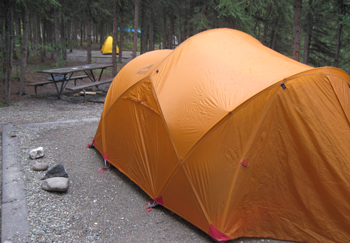
Lucy Tyrell
Study 1: Cost-benefit analysis of national parks
To determine the overall willingness-to-pay for visits to U.S. national parks compared to the costs of providing them to the public, Jared Hardner and Bruce McKenney, of Hardner and Gullison Associates conducted a study in 2006.
They estimated that the value or benefit of national parks to visitors is high, such that visitors are willing to pay four times what it costs to run the national parks (i.e., the tax dollars appropriated to parks). Cumulatively across all national parks in 2006, visitors were willing to pay $7.5 billion more for recreational benefits from parks than the tax dollar cost of parks.
In the case study for Denali, visitors were willing to pay (the value or benefit of the park) more than the national average on their park visit (nearly $50 per day—this includes such things as park admission and bus trips). However, the value-to-cost ratio for Denali was lower than for other parks (1.4 compared to the national average of 4.0). This value-to-cost ratio was especially high for Denali because it is costly to plow (spring) and maintain (summer) the Denali Park Road as well as to oversee a concession run bus system to provide recreational access.
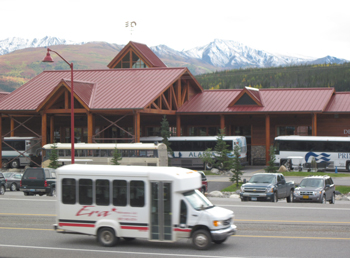
Lucy Tyrell
Study 2: Visitor spending in Denali
To estimate how visitors spend money while visiting Denali, Andrew Ackerman, Denali’s social scientist, and Daniel Stynes developed a model of visitor spending. They estimated expenditures based on bed-tax revenues for the two boroughs in which the park is located and on a national database with Alaska-specific revenues for spending categories.
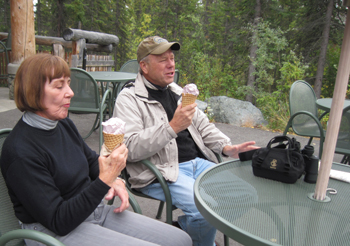
Lucy Tyrell
Visitors to Denali spent an estimated $104 million in 2008—plus more than $47 million on travel to and from the park. This spending can be broken down by where visitors spent the night; see table below. A visit is an entry into the park by a visitor during a 24-hour period.
Of the 400,000 estimated total visits to the park in 2008, 200,000 were made by individuals staying outside the park and spending $78.6 million, 116,000 made by day trippers spending $5.6 million, and 60,000 by campers spending $8 million (see table for visits that used Kantishna lodging and backcountry camping). Average spending per visit (last row in table) ranged from $48 for daytrippers to $488 for Kantishna lodge guests.
Visitor spending associated with visits to Denali is more complex than simply buying an ice cream cone. Researchers have demonstrated that the economic ripple effects from visits to national parks, including Denali, are at a scale that is large and wide-sweeping— impacting economies from local to global.
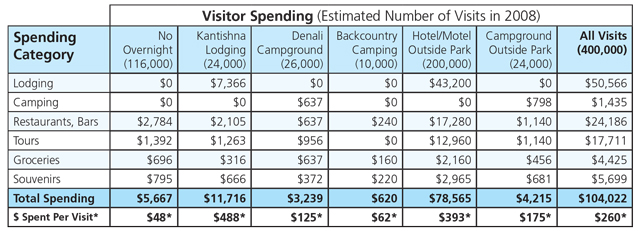
Last updated: October 26, 2021
